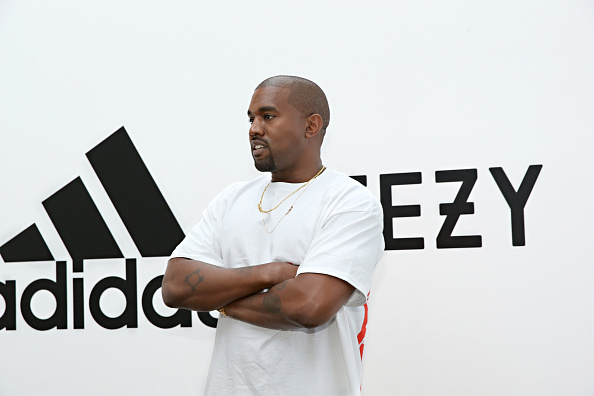Adidas Ends Kanye West Partnership, Gap Pulls Yeezy Products Over Rapper’s Anti-Semitic Remarks
Sportswear company’s move ends lucrative arrangement that produced the popular Yeezy collection of sneakers
Adidas AG said it would end its partnership with Kanye West and Gap Inc. said it would pull apparel he helped design from its stores, after a string of controversies including a recent anti-Semitic outburst from the musician and fashion-brand owner.
Adidas’s decision, which ends a lucrative arrangement that has produced the popular Yeezy collection of sneakers, comes after weeks of pressure on the German sportswear company from human-rights advocates and after other businesses severed their ties with Mr. West, who goes by Ye.
Gap, which ended its partnership with Mr. West in September but was still selling items it had already produced, said Tuesday that it was removing Yeezy Gap products from its stores and had shut down a website that was still selling hoodies and other merchandise from the partnership.
“Our former partner’s recent remarks and behaviour further underscore why” Gap ended its partnership, the retailer said in a statement.
Mr. West and his representatives didn’t immediately respond to requests for comment. He has publicly complained about Adidas and Gap, accusing the companies of stealing his designs and breaking promises to expand his ventures. He had said that he was key to Adidas’s success. “I can say antisemitic things and Adidas can’t drop me. Now what?” he said in a podcast that aired earlier this month.
In early October, Mr. West appeared at his Yzy fashion show in Paris wearing a “White Lives Matter” shirt, a slogan often used by white supremacist groups, and a week later wrote a tweet that said in part that he planned to go “death con [sic] 3 on Jewish people.”
Film-and-television studio MRC and French fashion house Balenciaga are among companies that have distanced themselves from Mr. West in recent weeks. The talent agency CAA has dropped Mr. West as a client, according to a person familiar with the matter.
On Oct. 6, Adidas put its partnership with Mr. West under review. Days later, Twitter Inc. and Meta Platforms Inc.’s Instagram locked his accounts after he made anti-Semitic posts.
Adidas said Tuesday that Mr. West’s recent comments and actions have been “unacceptable, hateful and dangerous, and they violate the company’s values of diversity and inclusion, mutual respect and fairness.”
The breakup adds another major headwind for Adidas, which has been struggling to grow in China, the largest apparel and footwear market in the world. Adidas is also in the midst of searching for a new chief executive after the company unexpectedly said in August that its current leader, Kasper Rorsted, will step down next year.
“The termination of the partnership with Kanye West is understandable and necessary. Financially, the termination is a heavy blow,” said Ingo Speich, head of sustainability and corporate governance at German fund manager Deka Investment, which holds 0.7% of Adidas. “It remains to be hoped that no further partnerships will be lost.”
Adidas said it would terminate the partnership immediately, end production of Yeezy branded products and stop all payments to Mr. West and his companies. The decision is expected to have a short-term hit of up to €250 million, equivalent to $247 million, on the company’s net income in 2022, the company said.
Adidas shares fell more than 3% in Frankfurt trading Tuesday. They are down more than 60% this year.
Over the weekend, protesters in Los Angeles held a banner above a major freeway expressing support for Mr. West’s statements. “Kanye is right about the Jews,” it read.
After photos of the incident circulated on social media, a chorus of celebrities condemned anti-Semitism in online posts, including Kim Kardashian, who filed for divorce from Mr. West in 2021.
“Hate speech is never OK or excusable,” she wrote on Twitter on Monday. “I stand together with the Jewish community and call on the terrible violence and hateful rhetoric towards them to come to an immediate end.”
Human-rights campaigners in recent days had publicly criticised Adidas over its partnership with Mr. West. On Tuesday, the Central Council of Jews in Germany called on the company to end its partnership with the artist.
“As a German company, I simply expect from Adidas a clear stance when it comes to anti-Semitism,” the organisation’s president, Dr. Josef Schuster, said on Twitter. “Entrepreneurial interests must not be the priority.”
Addressing Adidas, Jonathan Greenblatt, chief executive of the Anti-Defamation League, tweeted on Monday that “your silence is a danger to Jews.”
Adidas on Tuesday said it “does not tolerate anti-Semitism and any other sort of hate speech.”
Mr. West’s ventures in sneakers date to at least 2006 when he first collaborated with Adidas on a shoe that was never released. A year later the rapper started working with Nike Inc. and eventually released the coveted Nike Air Yeezy II, which included the famed Red Octobers. The Nike partnership ended in 2013.
Items that the artist designed in collaboration with Adidas made their debut in 2015, and the parties entered a long-term partnership the following year.
In the arrangement, Mr. West lends the Yeezy brand to the company in return for royalties of about 15% of the sales of Yeezy products. Adidas designs and manufactures the products, and it owns the designs, according to people familiar with the deal.
The partnership has been a boon for Adidas. The tie-up accounts for as much as 8% of Adidas’s total sales, analysts at UBS said in a report last week.
Without the partnership, the company’s annual sales have grown just 1% on average since 2017 compared with the actual sales growth of 3%, UBS estimated. Adidas has said that its partnership with Yeezy was one of the most successful collaborations in the industry.
But in recent months, Mr. West has criticised Adidas, as well as Gap, on social media. Gap decided to end its relationship with Mr. West last month, saying the company and Mr. West are “not aligned” in how they work together, The Wall Street Journal has reported.
Earlier this month, Adidas said it made repeated attempts to privately resolve disputes with Mr. West.
The breakup with Mr. West piles further pressure on the sporting goods maker, days after it cut its full-year guidance, citing a weaker business environment in China as well as a significant inventory buildup as a result of lower consumer demand in major Western markets. Other factors, such as suspended operations in Russia and the supply-chain problems that have engulfed global business, have contributed to the company’s lacklustre performance lately.
The company said on Thursday that it now expects currency-neutral revenue to grow by a mid-single-digit percentage rate in 2022, down from a mid- to high-single-digit percentage forecast previously.
Corrections & Amplifications
The musician and fashion-brand owner is Kanye West. An earlier version of this article incorrectly called him Kayne West in one instance. (Corrected on Oct. 25)
 Copyright 2020, Dow Jones & Company, Inc. All Rights Reserved Worldwide. LEARN MORE
Copyright 2020, Dow Jones & Company, Inc. All Rights Reserved Worldwide. LEARN MORE
This stylish family home combines a classic palette and finishes with a flexible floorplan
Just 55 minutes from Sydney, make this your creative getaway located in the majestic Hawkesbury region.
As Paris makes its final preparations for the Olympic games, its residents are busy with their own—packing their suitcases, confirming their reservations, and getting out of town.
Worried about the hordes of crowds and overall chaos the Olympics could bring, Parisians are fleeing the city in droves and inundating resort cities around the country. Hotels and holiday rentals in some of France’s most popular vacation destinations—from the French Riviera in the south to the beaches of Normandy in the north—say they are expecting massive crowds this year in advance of the Olympics. The games will run from July 26-Aug. 1.
“It’s already a major holiday season for us, and beyond that, we have the Olympics,” says Stéphane Personeni, general manager of the Lily of the Valley hotel in Saint Tropez. “People began booking early this year.”
Personeni’s hotel typically has no issues filling its rooms each summer—by May of each year, the luxury hotel typically finds itself completely booked out for the months of July and August. But this year, the 53-room hotel began filling up for summer reservations in February.
“We told our regular guests that everything—hotels, apartments, villas—are going to be hard to find this summer,” Personeni says. His neighbours around Saint Tropez say they’re similarly booked up.
As of March, the online marketplace Gens de Confiance (“Trusted People”), saw a 50% increase in reservations from Parisians seeking vacation rentals outside the capital during the Olympics.
Already, August is a popular vacation time for the French. With a minimum of five weeks of vacation mandated by law, many decide to take the entire month off, renting out villas in beachside destinations for longer periods.
But beyond the typical August travel, the Olympics are having a real impact, says Bertille Marchal, a spokesperson for Gens de Confiance.
“We’ve seen nearly three times more reservations for the dates of the Olympics than the following two weeks,” Marchal says. “The increase is definitely linked to the Olympic Games.”

Getty Images
According to the site, the most sought-out vacation destinations are Morbihan and Loire-Atlantique, a seaside region in the northwest; le Var, a coastal area within the southeast of France along the Côte d’Azur; and the island of Corsica in the Mediterranean.
Meanwhile, the Olympics haven’t necessarily been a boon to foreign tourism in the country. Many tourists who might have otherwise come to France are avoiding it this year in favour of other European capitals. In Paris, demand for stays at high-end hotels has collapsed, with bookings down 50% in July compared to last year, according to UMIH Prestige, which represents hotels charging at least €800 ($865) a night for rooms.
Earlier this year, high-end restaurants and concierges said the Olympics might even be an opportunity to score a hard-get-seat at the city’s fine dining.
In the Occitanie region in southwest France, the overall number of reservations this summer hasn’t changed much from last year, says Vincent Gare, president of the regional tourism committee there.
“But looking further at the numbers, we do see an increase in the clientele coming from the Paris region,” Gare told Le Figaro, noting that the increase in reservations has fallen directly on the dates of the Olympic games.
Michel Barré, a retiree living in Paris’s Le Marais neighbourhood, is one of those opting for the beach rather than the opening ceremony. In January, he booked a stay in Normandy for two weeks.
“Even though it’s a major European capital, Paris is still a small city—it’s a massive effort to host all of these events,” Barré says. “The Olympics are going to be a mess.”
More than anything, he just wants some calm after an event-filled summer in Paris, which just before the Olympics experienced the drama of a snap election called by Macron.
“It’s been a hectic summer here,” he says.

AFP via Getty Images
Parisians—Barré included—feel that the city, by over-catering to its tourists, is driving out many residents.
Parts of the Seine—usually one of the most popular summertime hangout spots —have been closed off for weeks as the city installs bleachers and Olympics signage. In certain neighbourhoods, residents will need to scan a QR code with police to access their own apartments. And from the Olympics to Sept. 8, Paris is nearly doubling the price of transit tickets from €2.15 to €4 per ride.
The city’s clear willingness to capitalise on its tourists has motivated some residents to do the same. In March, the number of active Airbnb listings in Paris reached an all-time high as hosts rushed to list their apartments. Listings grew 40% from the same time last year, according to the company.
With their regular clients taking off, Parisian restaurants and merchants are complaining that business is down.
“Are there any Parisians left in Paris?” Alaine Fontaine, president of the restaurant industry association, told the radio station Franceinfo on Sunday. “For the last three weeks, there haven’t been any here.”
Still, for all the talk of those leaving, there are plenty who have decided to stick around.
Jay Swanson, an American expat and YouTuber, can’t imagine leaving during the Olympics—he secured his tickets to see ping pong and volleyball last year. He’s also less concerned about the crowds and road closures than others, having just put together a series of videos explaining how to navigate Paris during the games.
“It’s been 100 years since the Games came to Paris; when else will we get a chance to host the world like this?” Swanson says. “So many Parisians are leaving and tourism is down, so not only will it be quiet but the only people left will be here for a party.”
This stylish family home combines a classic palette and finishes with a flexible floorplan
Just 55 minutes from Sydney, make this your creative getaway located in the majestic Hawkesbury region.






















